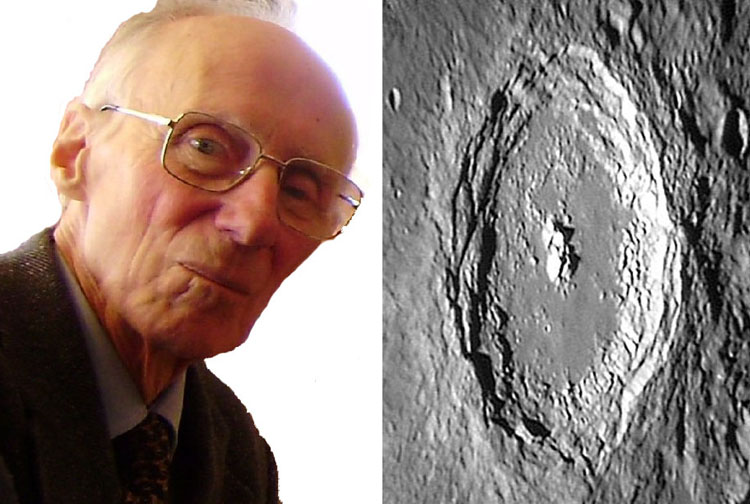Difference between revisions of "November 27, 2010"
| Line 3: | Line 3: | ||
<!-- ws:start:WikiTextHeadingRule:1:<h1> --> | <!-- ws:start:WikiTextHeadingRule:1:<h1> --> | ||
<!-- ws:start:WikiTextLocalImageRule:16:<img src="/file/view/LPOD-Nov27-10.jpg/182890307/LPOD-Nov27-10.jpg" alt="" title="" /> -->[[File:LPOD-Nov27-10.jpg|LPOD-Nov27-10.jpg]]<!-- ws:end:WikiTextLocalImageRule:16 --><br /> | <!-- ws:start:WikiTextLocalImageRule:16:<img src="/file/view/LPOD-Nov27-10.jpg/182890307/LPOD-Nov27-10.jpg" alt="" title="" /> -->[[File:LPOD-Nov27-10.jpg|LPOD-Nov27-10.jpg]]<!-- ws:end:WikiTextLocalImageRule:16 --><br /> | ||
| − | <em>Langrenus image by [mailto:kcpaulhk@yahoo.com.hk | + | <em>Langrenus image by [mailto:kcpaulhk@yahoo.com.hk K.C. Pau], Hong Kong, and Dollfus photo from [mailto:Raymond2weill@aol.com Laurent Weill], France</em><br /> |
<br /> | <br /> | ||
| − | On October 1, 2010 another giant of lunar and planetary astronomy of the 20th century died. Audouin Dollfus was born in 1925 and had a remarkably varied astronomical career, including the naked eye discovery of Saturn's moon Janus, and polarimetric studies of the Moon and the terrestrial planets. I talked with him a few times when he visited the Lunar and Planetary Lab during the 60s, and again at Lunar & Planetary Science Conferences in the 1990s. Here is part of an LPOD from [http://www.lpod.org/archive/archive/2004/04/LPOD-2004-04-18.htm | + | On October 1, 2010 another giant of lunar and planetary astronomy of the 20th century died. Audouin Dollfus was born in 1925 and had a remarkably varied astronomical career, including the naked eye discovery of Saturn's moon Janus, and polarimetric studies of the Moon and the terrestrial planets. I talked with him a few times when he visited the Lunar and Planetary Lab during the 60s, and again at Lunar & Planetary Science Conferences in the 1990s. Here is part of an LPOD from [http://www.lpod.org/archive/archive/2004/04/LPOD-2004-04-18.htm April 18, 2004] discussing Dollfus' observations of one of the best documented lunar transient events: <em>The experienced French astronomer Audouin Dollfus discovered that the northern floor of Langrenus temporarily brightened when seen in polarized light on December 30, 1992 and on January 2, 1993. Dollfus' interpretation was that the bright polarized areas were produced by outgassing that lifted dust above the crater floor. This is a peculiar, but well-documented observation, and is made more believable by enhanced concentrations of radon at Langrenus and nearby Fecunditatis detected during Apollo 15 and 16 missions. Perhaps the fact that the central peaks of Langrenus sampled deep crustal rocks has some connection to the proposed degassing. Have any additional polarimetric brightenings occurred since 1973? Has anyone looked? It is now within the capability of amateur imagers!</em><br /> |
<br /> | <br /> | ||
| − | <em>[mailto:tychocrater@yahoo.com | + | <em>[mailto:tychocrater@yahoo.com Chuck Wood]</em><br /> |
<br /> | <br /> | ||
<strong>Technical Details</strong><br /> | <strong>Technical Details</strong><br /> | ||
| Line 14: | Line 14: | ||
<strong>Related Links</strong><br /> | <strong>Related Links</strong><br /> | ||
Rükl plate [http://the-moon.wikispaces.com/R%C3%BCkl+49 49]<br /> | Rükl plate [http://the-moon.wikispaces.com/R%C3%BCkl+49 49]<br /> | ||
| − | [http://news.bbc.co.uk/2/hi/science/nature/789095.stm | + | [http://news.bbc.co.uk/2/hi/science/nature/789095.stm Light glows on the Moon - BBC]<br /> |
Audouin Dollfus (2000) Lunar Surface Imaging Polarimetry. III. Langrenus, Icarus 420-429<br /> | Audouin Dollfus (2000) Lunar Surface Imaging Polarimetry. III. Langrenus, Icarus 420-429<br /> | ||
Audouin Dollfus (2000) Langrenus: Transient Illuminations on the Moon, Icarus 430-443<br /> | Audouin Dollfus (2000) Langrenus: Transient Illuminations on the Moon, Icarus 430-443<br /> | ||
| Line 20: | Line 20: | ||
<br /> | <br /> | ||
<hr /> | <hr /> | ||
| − | <div>You can support LPOD when you buy any book from Amazon thru [http://www.lpod.org/?page_id=591 | + | <div>You can support LPOD when you buy any book from Amazon thru [http://www.lpod.org/?page_id=591 LPOD!]<br /> |
</div> | </div> | ||
---- | ---- | ||
===COMMENTS?=== | ===COMMENTS?=== | ||
| − | + | Register, and click on the <b>Discussion</b> tab at the top of the page. | |
Revision as of 17:27, 11 January 2015
Audouin Dollfus

Langrenus image by K.C. Pau, Hong Kong, and Dollfus photo from Laurent Weill, France
On October 1, 2010 another giant of lunar and planetary astronomy of the 20th century died. Audouin Dollfus was born in 1925 and had a remarkably varied astronomical career, including the naked eye discovery of Saturn's moon Janus, and polarimetric studies of the Moon and the terrestrial planets. I talked with him a few times when he visited the Lunar and Planetary Lab during the 60s, and again at Lunar & Planetary Science Conferences in the 1990s. Here is part of an LPOD from April 18, 2004 discussing Dollfus' observations of one of the best documented lunar transient events: The experienced French astronomer Audouin Dollfus discovered that the northern floor of Langrenus temporarily brightened when seen in polarized light on December 30, 1992 and on January 2, 1993. Dollfus' interpretation was that the bright polarized areas were produced by outgassing that lifted dust above the crater floor. This is a peculiar, but well-documented observation, and is made more believable by enhanced concentrations of radon at Langrenus and nearby Fecunditatis detected during Apollo 15 and 16 missions. Perhaps the fact that the central peaks of Langrenus sampled deep crustal rocks has some connection to the proposed degassing. Have any additional polarimetric brightenings occurred since 1973? Has anyone looked? It is now within the capability of amateur imagers!
Chuck Wood
Technical Details
Sept 12, 2003. 10" f/6 Newtonian plus 5x barlow plus Philips Toucam Pro, 130 frames stacked. Seeing 4/10, transparency 5/10.
Related Links
Rükl plate 49
Light glows on the Moon - BBC
Audouin Dollfus (2000) Lunar Surface Imaging Polarimetry. III. Langrenus, Icarus 420-429
Audouin Dollfus (2000) Langrenus: Transient Illuminations on the Moon, Icarus 430-443
Hodges, C.A. USGS I739 Geologic map of the Langrenus Quadrangle of the Moon. 1973 1:1,000,000
COMMENTS?
Register, and click on the Discussion tab at the top of the page.



